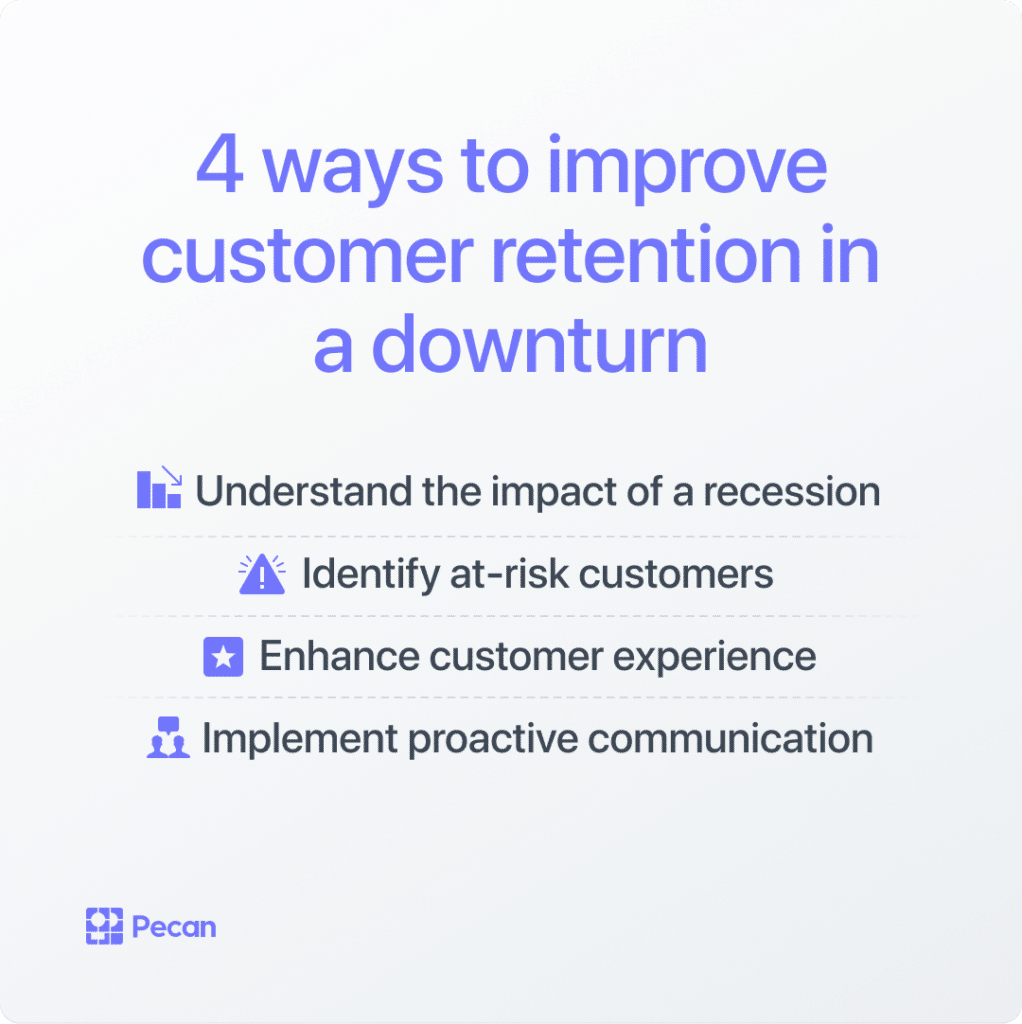The last few years have introduced a host of unexpected economic challenges, from the COVID pandemic to supply chain issues, from high inflation to tumultuous stock markets.
Such challenges have contributed to a rapidly changing economic environment, which has in turn led to mass layoffs among tech companies, slashed company valuations, curtailed investments, and resulted in significant corporate cost-cutting. Over at Meta, Mark Zuckerberg dubbed 2023 the “Year of Efficiency” in an effort to dramatically reduce costs and boost profit margins.
The companies that will emerge even stronger from this crisis are those that have been able to maintain efficiency while continuing to provide exceptional value to their customers. Customer retention is of prime importance, and the consequences of overlooking it can be severe, leading to reduced customer loyalty and significant revenue loss.
In this article, we’ll explore the crucial role of customer retention during difficult economic times, and how companies can take steps to achieve greater customer retention.
Actions you can take before a recession begins
To ensure long-term success and sustainability, every business should anticipate and plan ahead for potential recessions, market downturns, and unforeseen global events. These can have significant and sometimes devastating impacts on businesses. But by proactively anticipating and preparing for them, you can take steps to safeguard your company and maintain a competitive edge.
For business leaders, this could mean diversifying revenue streams, developing contingency plans for certain operations, or maintaining a strong balance sheet, to weather the economic storm.
But if you’re a data analyst or sit outside the C-suite, what can you do? Depending on your role, you might feel like these bigger strategic decisions are outside the scope of your everyday work. However, there are ways you can help your company get ahead of economic challenges by making the most of its data.
Here are a few proactive steps you can take to overcome business challenges during a recession and beyond:
1. Analyze data from previous recessions or economic downturns to identify patterns, trends, and key indicators that provide insights into how your sector or industry was affected. Some questions you might ask include:
- How did customer priorities and expectations shift as a result of the downturn?
- How did this affect customers’ purchasing habits? In what areas did they reduce or increase their spending?
- What was the impact on your churn rate and sales performance?
- How did your company adapt to such changes, if at all? What was or wasn’t successful?
2. Create predictive models to forecast potential scenarios and outcomes during a recession. This will be possible once you’ve built an AI model that’s able to predict customer loyalty and retention. Such a model will naturally include dozens of variables pertaining to customer behavior and demographics, which you can then complement with variables like seasonal trends and economic factors. Once that model is in use, you can simulate potential outcomes (such as customer churn or conversion).
3. Be aware of leading economic indicators such as GDP growth, unemployment, consumer spending, interest rates, and stock market trends. By no means are you expected to become an economic whiz or financial prognosticator. But keeping your finger on the pulse of economic trends will help alert you to economic headwinds – giving an indication that it’s time to start planning for potential economic disruption.
4. Stay up to date on market trends and emerging technologies. This is always a good idea as you strive to become more proficient and productive in your role. But it can also help you identify potential risks and seize new opportunities when the market begins to turn. For example: At a time when many companies are being forced to cut costs, how can you leverage recent developments in AI to drive revenue or improve operational efficiency?
4 ways to improve customer retention during a recession
Customer retention is especially important during an economic downturn. The impact of revenue losses and customer attrition can be devastating.
And although acquiring new customers is an important way to promote growth and minimize losses, it should not come at the expense of retaining your existing customer base. One reason is that it is 6 to 7 times more expensive to acquire new customers than to retain existing ones. And this number may be even higher during a recession, when new customers are more hesitant to buy.
This well-known statistic is likely one reason why the 2022 Twilio Growth Report found that, during recessionary periods, 67% of businesses focus more on customer retention than customer acquisition.
And in the words of Brian Balfour, former VP of Growth at Hubspot, “If you don’t have good retention and don’t understand retention, literally nothing else matters.”
https://youtu.be/ch7aps2h8zQ
In this lecture, Brian Balfour illustrates why customer retention is a company’s most important growth metric.
So how can you strategically invest in customer retention efforts and bolster the resilience of your company?
1. Understand the impact of a recession
Both individual consumers and businesses may alter their purchasing behaviors during a recession. This may be a result of financial constraints, changing priorities, or greater caution.
Your job is to analyze how a recession may affect your target market, including their purchasing habits, their needs, their preferences, their priorities, and what other stakeholders may be involved in their decision-making.
Once you have a better understanding of the challenges posed by a recession, as well as how your customers are likely to respond to them, you’ll be in a better position to take steps towards improving retention and mitigating churn.
Here are just a few steps you could take to better understand your customers and their buying behavior:
- Work with your marketing team to understand customer acquisition channels and campaign performance. Understanding what works can shed light on what attracts customers to your product or service.
- Conduct surveys to gather specific feedback from customers about their buying decisions, pain points, motivations, and goals.
- Group your customers into different segments (based on demographics, purchase patterns, etc.) so you can analyze their needs and behaviors separately, and achieve more focused insights.
- Implement A/B testing on your website or mobile app to experiment with different features, layouts, and pricing options, and observe how customers respond.
Once you’ve gathered these types of information, you’ll be in a better place to act on that data – for example, by building a model to predict churn, working with other teams to optimize marketing or sales campaigns, or recommending A/B tests within your product.
2. Identify at-risk customers
Losing customers during a recession can have long-lasting repercussions. Aside from the immediate revenue loss, it can have a ripple effect on your brand reputation, market position, and future growth potential.
Nevertheless, as many as 44% of businesses fail to measure their retention rate – let alone proactively address it. Among those who do attempt to measure and predict churn, they tend to rely on rule-based business models that can be built using traditional BI tools. The problem? Models that are based on just one or two variables are not likely to be accurate enough to guide your retention efforts.
As a data analyst, you can easily build predictive models that are able to identify customers who are most likely to churn. Through the use of a predictive analytics platform, you can include a limitless number of relevant variables, such as purchase history, frequency of engagement, customer sentiment, changes in behavior, and even macroeconomic data.
Then, by proactively identifying at-risk customers with a high degree of accuracy, you can guide your company toward targeted retention activities
3. Enhance customer experience
During a recession, tech companies should often – and may have no choice but to – shift their focus from short-term gains to existing customer relationships. This is consistent with a recent report in which 65% of surveyed companies said they were planning to increase spending on customer experience initiatives in 2023.
The way to solidify – and hopefully expand – your position as a trusted brand is by consistently delivering value, personalizing experiences, and providing exceptional customer support. And this is especially true in today’s crowded marketplace, where over two-thirds of companies compete mainly on the basis of customer experience.
As a data analyst, there are myriad ways you can make an impact on retention, and a wide array of tools and methodologies to take advantage of. One way to get started is by identifying pain points in the customer journey and areas where the customer experience can be improved. You might do this by obtaining insights with a data analytics platform, conducting A/B tests within digital customer experiences, performing an analysis of customer support tickets, or designing and analyzing a survey for customers.
By taking concrete steps to analyze the customer experience and then improve it, you’ll help drive greater customer loyalty and reduced churn. And remember: the cost of pursuing retention initiatives and investing in retention tools (such as a predictive analytics platform) will always be less than the cost of acquiring new customers to replace churned ones.
4. Implement proactive communication
Customers develop emotional attachment to particular brands, and companies can leverage this to great effect during a recession. How so? By offering positive support to customers during challenging times, certain brands have been able to mitigate the adverse effects of economic downturns and position themselves for future growth once the market stabilizes.
A great example of this is Adobe. During the Great Recession of 2008, when corporate spending dwindled and technology budgets tightened, the company made a concerted effort to prioritize customer support and engagement. Some of the ways they did this is by offering more flexible licensing options, continuing to enhance their software offerings, and launching campaigns to highlight how their tools could help businesses and individuals thrive during challenging times. This helped Adobe further solidify its place in the market, while bolstering their brand reputation and customer loyalty.
Cultivating strong relationships with existing customers doesn’t just build trust and brand loyalty, It also strengthens the foundation for long-term success. Indeed, one study found that increasing customer retention rates by as little as 5% can lead to an increase in profits ranging from 25% to 95%.
So what can you do as a data analyst? For starters, you can gather data to identify key touchpoints in the customer journey where proactive communication can make a difference. For example: is there a particular point when customers tend to reach out for support, complain to customer service, or abandon their activity? If so, these are great opportunities to provide relevant information, updates, or support, and to address any concerns they have.
Identifying such pain points will help your team develop targeted communication strategies so you can engage positively with customers during difficult times, and ultimately, improve customer retention.
Get equipped now to maximize retention
Whether now or in the future, every company will need to battle through an economic downturn at some point. And as a data analyst, by taking proactive steps and adopting a forward-thinking approach, you can help your organization not only survive, but also thrive – by pursuing data-driven retention initiatives that position it for long-term growth and success.
If you’d like to find out how Pecan can help you identify high-risk customers and dramatically reduce churn, schedule a demo and we’ll show you the amazing predictive power of our fully customizable churn models.
Ready to see how easy it can be to use predictive analytics to supercharge your data analytics role? Give us 30 minutes of your time and let us show you how it works, or sign up for a free trial now and try it yourself!




